Submitted by chandra on Wed, 2012-11-28 10:45
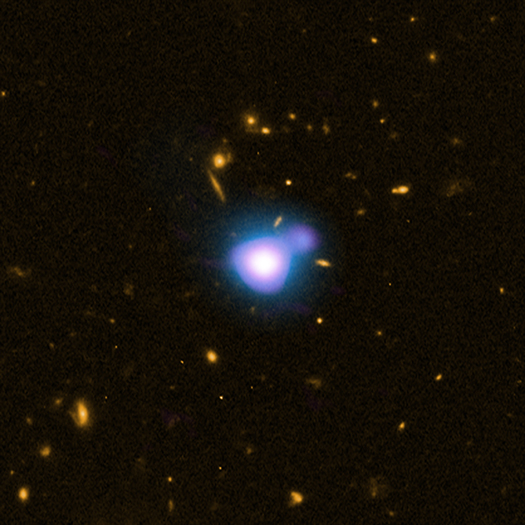
This composite image shows the most distant X-ray jet ever observed. X-ray data from NASA's Chandra X-ray Observatory are shown in blue, radio data from the NSF's Very Large Array are shown in purple and optical data from NASA's Hubble Space Telescope are shown in yellow. The jet was produced by a quasar named GB 1428+4217, or GB 1428 for short, and is located 12.4 billion light years from Earth. Labels for the quasar and jet can be seen by mousing over the image. The shape of the jet is very similar in the X-ray and radio data.
Submitted by chandra on Wed, 2012-10-24 10:34
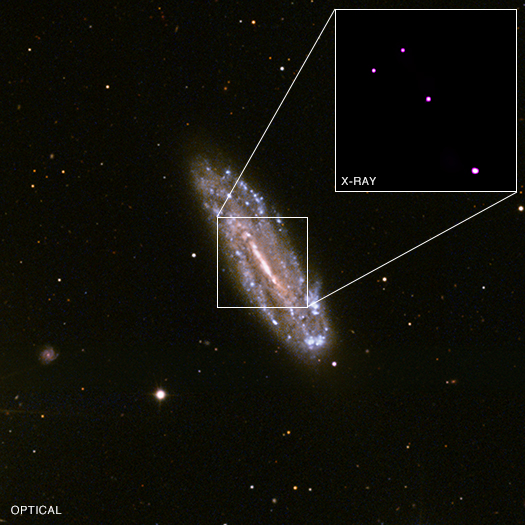
One of the lowest mass supermassive black holes ever observed in the middle of a galaxy has been identified, thanks to NASA's Chandra X-ray Observatory and several other observatories. The host galaxy is of a type not expected to harbor supermassive black holes, suggesting that this black hole, while related to its supermassive cousins, may have a different origin.
Submitted by chandra on Fri, 2012-06-01 19:39
For more context on CID-42 and the science of black hole kicks, we interviewed Professor Abraham (Avi) Loeb, one of the co-authors of the new paper. Avi is the director of the Institute for Theory and Computation, within the Harvard-Smithsonian Center for Astrophysics, and he is currently serving as Chair of the Department of Astronomy at Harvard University. He was recently elected to become a member of the American Academy of Arts & Sciences. Avi has worked on a wide variety of topics in astrophysics, including cosmology, black holes, gravitational lensing by planets and gamma-ray bursts in the distant Universe.
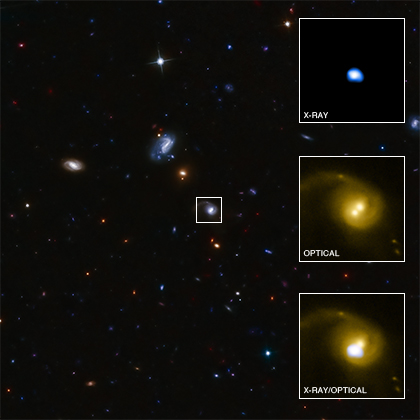
Q: How significant do you think this result is?
A: CID-42 is the best candidate for a massive black hole that might have been kicked out of the center of a galaxy with a high speed. An interesting mechanism for obtaining such a kick involves the merger of two black holes into the kicked black hole.
Submitted by chandra on Tue, 2011-10-25 12:52
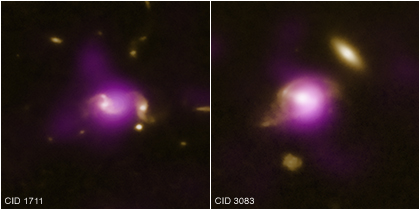
Astronomers have used a large survey to test a prediction that close encounters between galaxies can trigger the rapid growth of supermassive black holes. Key to this work was Chandra's unique ability to pinpoint actively growing black holes through the X-rays they generate.
The researchers looked at 562 pairs of galaxies ranging in distances from about 3 billion to 8 billion light years from Earth. They found that the galaxies in the early stages of an encounter with another were more likely than isolated, or "lonelier" galaxies to have actively growing black holes in their cores.
Submitted by chandra on Wed, 2011-08-31 12:04

Evidence for a pair of supermassive black holes in a spiral galaxy has been found in data from NASA's Chandra X-ray Observatory. This main image is a composite of X-rays from Chandra (blue) and optical data from the Hubble Space Telescope (gold) of the spiral galaxy NGC 3393. Meanwhile, the inset box shows the central region of NGC 3993 as observed just by Chandra.
Submitted by chandra on Thu, 2011-08-11 10:55
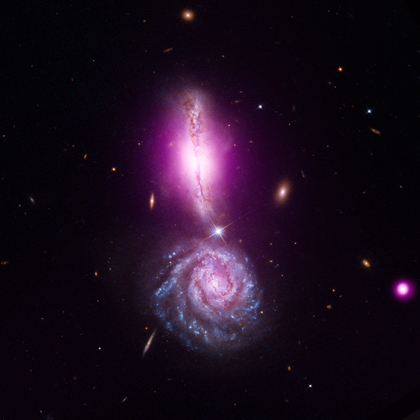
VV 340, also known as Arp 302, provides a textbook example of colliding galaxies seen in the early stages of their interaction. The edge-on galaxy near the top of the image is VV 340 North and the face-on galaxy at the bottom of the image is VV 340 South. Millions of years later these two spirals will merge - much like the Milky Way and Andromeda will likely do billions of years from now. Data from NASA's Chandra X-ray Observatory (purple) are shown here along with optical data from the Hubble Space Telescope (red, green, blue). VV 340 is located about 450 million light years from Earth.
Submitted by chandra on Thu, 2011-03-10 09:51
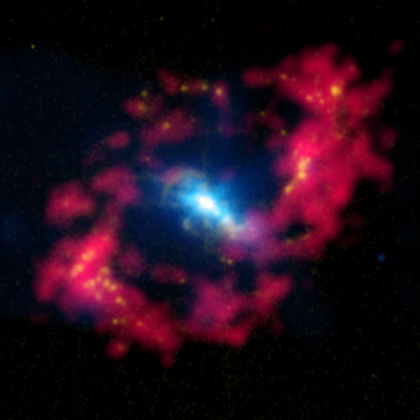
This composite image shows the central region of the spiral galaxy NGC 4151, dubbed the "Eye of Sauron" by astronomers for its similarity to the eye of the malevolent character in "The Lord of the Rings". In the "pupil" of the eye, X-rays (blue) from the Chandra X-ray Observatory are combined with optical data (yellow) showing positively charged hydrogen ("H II") from observations with the 1-meter Jacobus Kapteyn Telescope on La Palma. The red around the pupil shows neutral hydrogen detected by radio observations with the NSF's Very Large Array. This neutral hydrogen is part of a structure near the center of NGC 4151 that has been distorted by gravitational interactions with the rest of the galaxy, and includes material falling towards the center of the galaxy. The yellow blobs around the red ellipse are regions where star formation has recently occurred.
Submitted by chandra on Wed, 2010-08-18 11:28
This image shows the eruption of a galactic "super-volcano" in the massive galaxy M87, as witnessed by NASA's Chandra X-ray Observatory and NSF's Very Large Array (VLA). At a distance of about 50 million light years, M87 is relatively close to Earth and lies at the center of the Virgo cluster, which contains thousands of galaxies.
Submitted by chandra on Wed, 2010-06-30 10:38

Evidence for a recoiling black hole has been found using data from the Chandra X-ray Observatory, XMM-Newton, the Hubble Space Telescope (HST), and several ground-based telescopes. A new paper reports that this black hole kickback was caused either by a slingshot effect produced in a triple black hole system, or from the effects of gravitational waves produced after two supermassive black holes merged a few million years earlier.
Submitted by chandra on Tue, 2010-05-11 11:23

Scientists have used NASA's Chandra X-ray Observatory and ESA's XMM-Newton to detect a vast reservoir of gas lying along a wall-shaped structure of galaxies about 400 million light years from Earth. In this artist's impression, a close-up view of the so-called Sculptor Wall is depicted. Spiral and elliptical galaxies are shown in the wall along with the newly detected intergalactic gas, part of the so-called Warm Hot Intergalactic Medium (WHIM), shown in blue. This discovery is the strongest evidence yet that the "missing matter" in the nearby Universe is located in an enormous web of hot, diffuse gas.
Pages